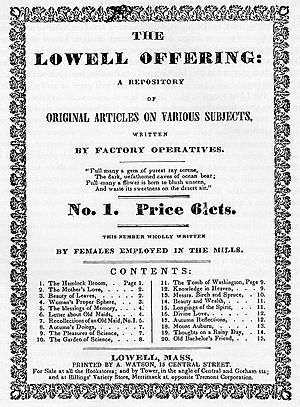Lowell Offering facts for kids

Cover of the Lowell Offering, Series 1, No. 1
|
|
|
Abbreviated title (ISO 4)
|
Lowell Offer. |
|---|---|
| Discipline | Literary journal |
| Language | English |
| Edited by | Harriot Curtis, Harriet Farley et al. |
| Publication details | |
|
Publication history
|
1840–1845, succeeded by New England Offering |
| Frequency | Monthly |
The Lowell Offering was a special magazine. It was made by young women who worked in textile mills. These women were often called the Lowell Mill Girls. They lived in Lowell, Massachusetts, during the early Industrial Revolution. The magazine was published every month. It featured their own poetry and stories. It started in 1840 and continued until 1845. It was a unique way for these factory workers to share their thoughts and creativity.
Contents
History of the Lowell Offering
How the Magazine Started
The Lowell Offering began in 1840. A pastor named Reverend Abel Charles Thomas helped organize it. At first, it shared writings from local reading groups. Soon, it started getting stories and poems from many more young women. These women worked in the Lowell mills. The magazine became very popular. Hundreds of people from all over New England read and supported it. Even visitors from other countries enjoyed it.
What the Mill Girls Wrote About
As the magazine grew, the workers wrote many things. They contributed poems, songs, essays, and fiction. Often, they used characters in their stories to talk about their lives. They shared what it was like to work in the mills. The magazine had both serious and funny articles. For example, one early article talked about the importance of "old maids." Later, especially when workers were unhappy, articles discussed the value of working together.
Life in the Mills
Many women who worked in the mills were not happy. They disliked the long hours and noisy conditions. They often wished to go back home to their farms. Many also missed their families.
However, many young women were also drawn to the mills. They wanted to learn and become independent. They used their time at the Lowell Mills to gain an education. They learned to read and write. Some even practiced music and foreign languages. The Lowell Offering gave them a chance to use these new skills.
Harriet Farley's Role
Harriet Farley was one of these mill girls. In 1838, she left her home to work in Lowell's textile mills. Her family and friends did not want her to go. She worked 11 to 13 hours a day. She lived in a crowded company boardinghouse. But she felt free to "read, think and write." She soon started writing for the new Lowell Offering. In 1842, she became its co-editor with Harriot Curtis. The magazine later came back in 1848 as the New England Offering. It collected writings from working women all over New England.
Notable Writers and Contributors
Here are some of the women who wrote for the Lowell Offering:
- Betsey Guppy Chamberlain
- Harriet Farley
- Lucy Larcom
- Harriet Hanson Robinson
- Augusta Harvey Worthen
- Sarah Bagley
- Abba Goddard
- Eliza Jane Cate
Modern Use of the Name
The University of Massachusetts Lowell has a student literary magazine. It uses the title Lowell Offering today. This is a way to honor the original magazine and its history.

